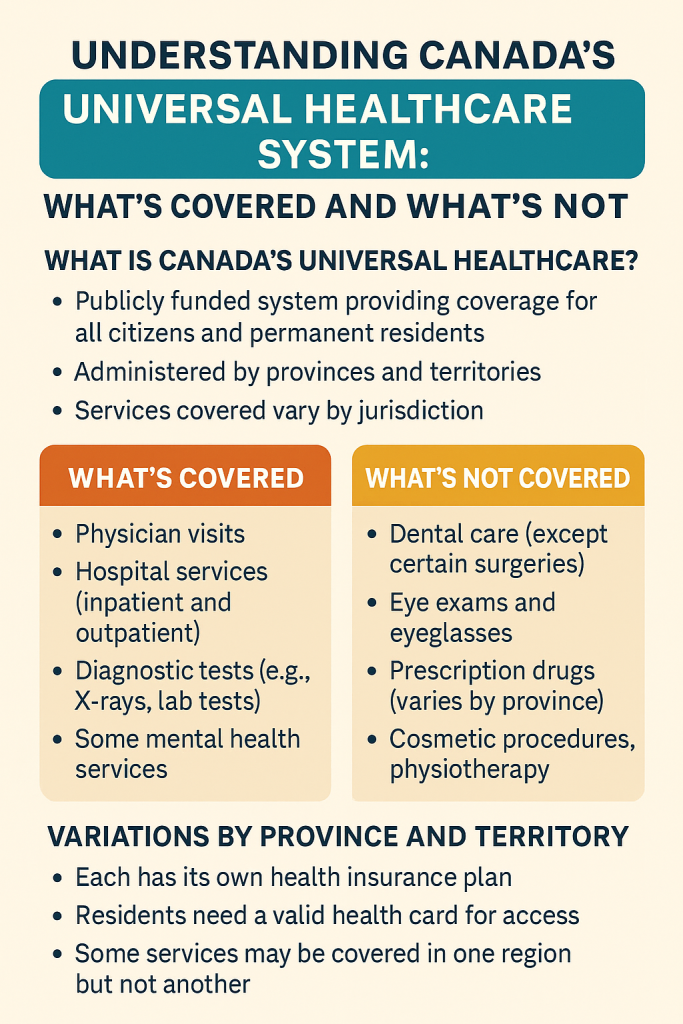Canada’s healthcare system is one of the most recognized features of the country’s social structure. Known for its universal access, it ensures that eligible residents receive medically necessary healthcare services without direct charges at the point of care. However, while the system is comprehensive, it is not without limitations. Understanding what is and isn’t covered is key for residents and newcomers alike.
What Is Canada’s Universal Healthcare System?
Often referred to as “Medicare,” Canada’s healthcare system is publicly funded and primarily administered at the provincial and territorial levels. The federal government sets national standards, but the actual delivery and administration are managed locally. This decentralized approach allows each province to tailor services, though core medical services are universally provided across Canada.
Eligibility is generally extended to Canadian citizens, permanent residents, and certain temporary residents. New immigrants may have to undergo a waiting period before coverage begins, depending on the province.
What’s Covered Under Public Healthcare
The term “medically necessary” is central to what the Canadian healthcare system covers. The following services are typically included:
- Physician Visits: Appointments with family doctors and specialists referred by them.
- Hospital Services: Emergency care, surgeries, hospital stays, and diagnostics provided in hospitals.
- Diagnostic Tests: Laboratory tests, X-rays, and other imaging when prescribed by a healthcare provider.
- Mental Health Services: Basic mental health consultations, often through primary care or hospitals, though coverage can vary by province.
What’s Not Covered
Despite its strengths, public healthcare in Canada does not extend to every aspect of health and wellness. Services typically not covered include:
- Dental Care: Routine check-ups, cleanings, and procedures, unless performed in a hospital.
- Vision Care: Eye exams and corrective lenses are not covered for adults in most provinces.
- Prescription Drugs: Outside of hospitals, most medications are not covered unless through specific provincial programs.
- Paramedical Services: Physiotherapy, chiropractic care, massage therapy, and other allied health services.
Differences Across Provinces and Territories
Each province and territory manages its own health insurance plan:
- Ontario: OHIP
- British Columbia: MSP
- Quebec: RAMQ
Coverage nuances exist. For instance, Quebec residents must also enroll in the provincial drug insurance plan if they do not have private coverage. Some provinces offer partial coverage for vision or dental for children or seniors.
Private Insurance and Supplemental Benefits
To bridge the gaps in public coverage, many Canadians opt for private health insurance. Employer-sponsored plans are common and may cover:
- Dental and vision care
- Prescription medications
- Paramedical services
- Travel insurance
For those without employer benefits, individual plans are available through private insurers. These are especially useful for international students, self-employed individuals, and retirees.
Accessing Public Healthcare Services
To access services, residents must:
- Register for a Health Card: Apply through the provincial or territorial health ministry.
- Find a Family Doctor: This can be challenging in some areas; walk-in clinics serve as an alternative.
- Use Walk-in Clinics and Telehealth: Useful for non-emergency issues when a family doctor is not available.
Conclusion
Canada’s healthcare system offers high-quality, accessible services for essential medical needs. However, understanding the boundaries of public coverage—and supplementing it when needed—is essential. Whether you’re a long-time resident or a newcomer, being informed helps you make the most of what Canada’s healthcare system has to offer.

Keywords: Canada healthcare system, universal healthcare in Canada, what is covered by Canadian healthcare, public vs private health insurance in Canada, healthcare for newcomers Canada


